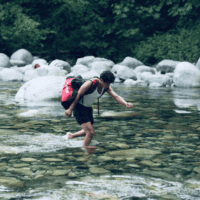Peak Performance Solutions takes a look at one of the most important items in your pack. It is the one item that will keep you alive when the weather turns bad in the outdoors, therefore it is important to look after it.
How to fix a cold night in a sleeping bag
I’ve encountered numerous people in the bush who own high-quality sleeping bags yet still find themselves shivering in the cold of the night.

Naturally, this piqued my curiosity, and I took the opportunity to inquire about their experiences. I asked them, “How many layers of clothing are you wearing overnight in your sleeping bag?”
The response was surprising to some extent. Many of them admitted to wearing up to six layers of clothing and still feeling cold. It was at this point that I could provide a valuable piece of advice – “Well, there’s the problem,” I told them. Contrary to the instinct to layer up for warmth, in the context of a sleeping bag, less clothing often equals more warmth. The logic behind this is simple: your sleeping bag insulation works best when it can trap a layer of warm air around your body.
This warm air layer directly next to your skin helps to prevent the loss of body heat, keeping you warm throughout the night. However, excessive layers of clothing can hinder this process by preventing the sleeping bag insulation from creating that warm air buffer. Therefore, it’s often best to sleep wearing just a good base layer of clothing inside your sleeping bag.
Having a good quality sleeping mat is another aspect that can greatly affect your overall comfort and warmth during the night. The sleeping mat serves to insulate your sleeping bag from direct contact with the ground, which can otherwise draw away heat. The type of sleeping mat you choose, whether it’s an inflatable, foam, or self-inflating one, can significantly impact your sleep quality in the outdoors. So, take the time to consider the specific demands of your adventure, the terrain you’ll encounter, and your own comfort to ensure you have a peaceful and warm night’s rest, ready to embrace the challenges of the wilderness the next day.
Down sleeping bags are renowned for their exceptional weight-to-warmth ratio, making them a preferred choice among outdoor enthusiasts. This characteristic means they are not only highly efficient at providing warmth but also lightweight, reducing the overall weight on your back during long hikes or camping trips. Their compactness is another significant advantage, as down bags can be easily stowed away in compression stuff sacks, saving precious space in your backpack.
However, it’s essential to be aware of one significant drawback when it comes to down bags. If down insulation gets wet, it loses its lofting ability, causing the down feathers to clump together. Once this occurs, the sleeping bag loses its capability to keep the occupant warm. This is a critical factor to consider, especially in wet or damp environments.
In contrast, synthetic bags offer insulation properties similar to down bags, but they tend to be heavier and less compressible. The standout feature of synthetic bags is their ability to retain insulation even when wet. This makes them a more reliable choice for individuals who expect to face wetter than normal conditions, during outdoor adventures.
Your choice between down and synthetic sleeping bags should be influenced by various factors. The specific environment you plan to explore, expected weather conditions, space in your pack and the duration of your trip all play pivotal roles in determining which type of sleeping bag is best suited to your needs. For instance, if you’re an avid hunter likely to encounter wet conditions, a synthetic bag might be the better option. On the other hand, hikers embarking on multi-day journeys might lean toward down bags due to their lightweight and compressible nature.
Even with the right sleeping bag, it’s not uncommon to encounter individuals who still struggle with the cold in the wilderness. This can happen for various reasons, including inadequate insulation beneath the bag, insufficient or low-quality clothing, and a failure to properly seal the bag to prevent cold air from infiltrating. Furthermore, individual comfort levels and tolerance for cold can vary, so personal preferences and preparedness should always be taken into account when venturing into the outdoors.
Plan a Great Walk











